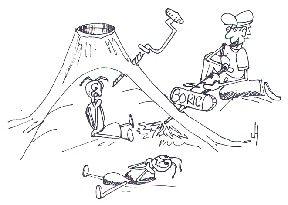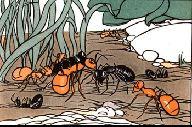Natural Solutions to Things That Bug You (9 page)
Read Natural Solutions to Things That Bug You Online
Authors: Myles Bader

Crawl spaces
Houses with cedar or plywood siding
Slightly slopping roof
Houses more than 7 years old
Houses with vegetation next to the house
Houses near a forest
PUT A TAIL ON THEM
 If you spot a carpenter ant, it is best to follow them to their nest. They come out late at night and you will need to place some honey out for them on a piece of cardboard or any other object that you can easily clean up. They will take the honey back to the nest.
If you spot a carpenter ant, it is best to follow them to their nest. They come out late at night and you will need to place some honey out for them on a piece of cardboard or any other object that you can easily clean up. They will take the honey back to the nest.
When you find their entrance, drill small holes and blow boric acid in to fill their living spaces. Boric acid will kill them! They may not be in the house and you may have to follow them outside to find the nest. It is critical to find the parent nest if you plan on getting rid of the colony.
ELIMINATE THE PROBLEM
Correct any water leaks on your property.
Eliminate any wood to ground contact points, especially where soil has been pushed up to the side of the house.
Make sure that there are no tree limbs or bushes touching the house.
Firewood should be a good distance from the house and elevated off the ground since this is their favorite location for a nest.
Old wood stumps are their favorite

A good quality poison-free killer is VICTOR POISON-FREE® ANT & ROACH KILLER. Comes in mint or cedar scents and is safe around kids and pets.
MAKE THEM SNEEZE
Mix together 1 teaspoon of table salt and ½ teaspoon of fine white pepper in 1-quart of water and mix well, then strain and spray the ants. This will work great to repel them and will kill the workers but not the queen.
OUTSIDE NESTING LOCATIONS
Forest, if within 100 yards of house………….25%
Live trees………………………………………..18%
Dead stumps, buried wood……………………16%
Landscape wood……………………………….. 7%
Stacked lumber/woodpile……………………… 3%

INSIDE NESTING LOCATIONS
The outside walls…………………..35%
Attic…………………………………..21%
Ceilings & crawl spaces……………20%
Stacked lumber, firewood, etc.
YOU MUST FIND ALL NESTS
Since carpenter ants have satellites as well as a home nest, it is necessary to locate all satellites as well as the home nest if you ever plan on eradicating them. You can find the nest in your home and destroy it but the workers will find a new nest in the home in very short order. Once you find the nest in your home you can spray the entire perimeter to stop a new housing development.
FIELD ANTS
General Information:
 Field ants are a very large group of ant species that make their nests in the ground in lawns, gardens and fields. Depending on the species, the workers range in size from 1/8” to ¼”. The color of field ants may be red, black or a combination of red and black. The ants usually nest near trees, sidewalks, fences or around the base of buildings. A number of species make a mound with the soil that they excavate under the ground.
Field ants are a very large group of ant species that make their nests in the ground in lawns, gardens and fields. Depending on the species, the workers range in size from 1/8” to ¼”. The color of field ants may be red, black or a combination of red and black. The ants usually nest near trees, sidewalks, fences or around the base of buildings. A number of species make a mound with the soil that they excavate under the ground.
Sometimes these mounds are mistaken for fire ant activity; however, field ants do not sting and only bite when they are disturbed. A number of field ants can spray formic acid while they bite, so their bites are painful.
Field ants love to eat honeydew, which is a sweet substance that they get from insects like mealybugs and aphids.
They locate the aphids on trees and shrubs, but some species of field ants, like the silky ants, keep herds of aphids so there is always a supply of honeydew. Field ants will also eat other insects and they are attracted to meats. Most species of field ants are scavengers.
Field ants do not usually invade homes but workers will often hunt for food on decks, porches, and patios. Sometimes people see black field ants on the wood deck and assume they are carpenter ants.
To prevent field ant problems, begin with a careful inspection and look for things that the ants might use as nesting sites such as firewood. It would be best to move mulch far away from the foundation to discourage ants from nesting. Make sure exterior doors close tightly and replace weather-stripping where it is missing.
RED FIRE ANTS

General Information:
 Fire ants are known for their aggressive behavior and will swarm over anyone or anything that disturbs their nest, often even attacking wild animals, small pet or people and in rare instances, even killing them.
Fire ants are known for their aggressive behavior and will swarm over anyone or anything that disturbs their nest, often even attacking wild animals, small pet or people and in rare instances, even killing them.
Their very painful sting affects about 42% of people in infested areas each year. About twenty million people are stung by fire ants in the United States every year!
Identifying Fire Ants
Fire ants have been known to enter home in search of food and water when outside conditions become intolerable for them. They may look like ordinary house or garden ants, but have some very distinguishing characteristics:
They vary in size within one nest, from 1/16 to 1/5 inch long.
They are dark reddish brown in color on the head and body, with a darker abdomen.
Their mounds can be more than 15 inches high, 15 inches in diameter and up to 5 feet deep.
When they are disturbed they are aggressive, especially near the nest.
They cause painful stings that raise a small welt.
If you are not sure if what you saw is fire ants, find a long branch and disturb the dirt in the mound then stick the branch into the top of it. Stay as far away as possible and the fire ants will climb right up what they perceive as an invader (the stick). Other ants will run around in a fit trying to protect the queen.

Anatomy of a fire ant
Fire ants have tiny waists, called petioles, so that they can wiggle their rear parts freely allowing them to twist and turn their bodies in the nest. It also makes it easier for them to enter tiny cracks in your house.
They are also very fastidious little critters since they clean dirt off their antennae by dragging them through the strigil (a comb) in the notch of their front legs. They also have scent glands on their abdomen, which release chemical odors that they use to mark trails when foraging food.
North American fire ants are unique in that they form colonies with multiple queens. The queen can live up to 2 to 7 years and in that time will bear 1,500 to 1,600 eggs per day. Some colonies may have 100,000 to 500,000 fire ants.